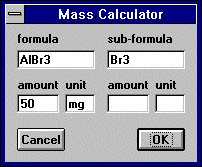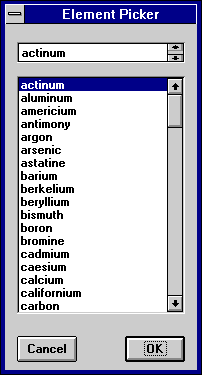
OMDI Element Tools for Excel
©1997 Octavian Micro Development Inc.
All Rights Reserved Worldwide.
OMDI Element Tools for Excel Documentation (draft 1.0)
Requirements
- Excel for Power Macintosh v5.0
- Excel for NT v5.0
- Excel for Windows95 v7.0
The OMDI Element Tools for Excel is an add-in that allows access to various
physical properties and related calculations for elements and isotopes.
Underneath "OMDIElem.XLL" is a data repository for 105 elements.
Commands
ElemMassCalculator

The mass calculator command is available from the OMDI menu, macro sheets,
etc. You must enter the short formula of a substance in the "formula"field, a contained sub-formula in the "sub-formula", and an amount
in one or the other "amount" fields. The mass calculator will
"fill in the blank" of the empty amount field; filling in the
currently selected cell. Optionally you may add an OMDI Unit compliant unit
string. If there is no unit, or if OMDI Unit Tools for Excel is not installed,
no unit conversion will take place. If one unit is filled in and the other
is not, the empty field indicates the corresponding amount field is in base
SI units (i.e. kg). If both fields are filled in, the amount is converted
from the given source units to the given destination units. Both units must
be of the same type (i.e. kg to g or mg*mol^-1 to lb*mol^-1.) For example,
if you want to work in atomic mass units, enter 'u' in both unit fields.
ElemElementPicker

The element picker command is available from the OMDI menu, macro sheets,
etc. By selecting an element by name, the active cell will be filled with
that element's atomic number. Atomic numbers are input to almost all OMDI
Element functions.
Functions
integer ElemAtomicNumber( symbol )
Return the atomic number of an element given its symbol.
string ElemMassUnit()
Return the OMDI Unit compliant unit string for mass functions (kg).
real ElemMass( atomicNumber )
Return the mass of an element given its atomic number. These masses are
based on empirical data.
real ElemMassCalc( shortFormula )
Returns the mass of a molecule given a short formula (symbols and mol count,
i.e. AlBr3.) The mass is based on empirical data. Currently, isotope
symbols for Deuterium (D) and Tritium (T) are supported.
real ElemMassEstimate( atomicNumber )
Return the estimated mass of an element given the atomic number. The estimate
is based on any available natural isotope information. It is a weighted
sum based on abundence.
real ElemAnyMass( numProtons, numNeutrons, numElectrons )
Return the mass based on the number of protons, neutrons, and electrons.
The mass is based on empirical data for protons, neutrons, and electrons.
string ElemName( atomicNumber )
Return the name of the element given the atomic number.
string ElemSymbol( atomicNumber )
Return the symbol of an element given the atomic number
integer ElemIUPACGroup( atomicNumber )
Return the IUPAC group number of an element given the atomic number. This
is the column number on a periodic table.
integer ElemPeriod( atomicNumber )
Return the period of an element given the atomic number. This is the
row number on a periodic table.
string ElemState( atomicNumber )
Return the state of an element given the atomic number. The result is "solid",
"liquid", or "gas" with the reference environment of
101 kPa ( 1 ATM ) and 298 K ( 25 °C ).
string ElemFamily( atomicNumber )
Return the family of an element given the atomic number. The family members
are "none", "noble_gas", "alkali_metal", "alkali_earth_metal",
"chalcogen", "halogen", "transition_metal",
"lanthanide", and "actinide."
string ElemMetal( atomicNumber )
Return the metallic properties of an element given the atomic number. The
result is "nonmetal", "metal", or "metalloid."
string ElemCrystalStructure( atomicNumber )
Return the crystal structure of an element given the atomic number. The
result is "unknown", "hexagonal", "body_centered_cubic",
"rhombohedral", "cubic", "monoclinic", "orthorhombic",
"face_centered_cubic", or "tetragonal."
string ElemElectronConfiguration( atomicNumber )
Return the electron configuration of an element given the atomic number.
real ElemAtomicRadius( atomicNumber )
Return the atomic radius of an element given the atomic number.
string ElemAtomicRadiusUnit()
Return the OMDI Unit compliant string for the atomic radius unit (m).
real ElemCovalentRadius( atomicNumber )
Return the covalent radius of an element given the atomic number.
string ElemCovalentRadiusUnit()
Return the OMDI Unit compliant string for the covalent radius unit (m).
real ElemAtomicVolume( atomicNumber )
Return the atomic volume of an element given the atomic number. The reference
environment for a gas is from the liquid state at normal boiling point.
For liquids and solids it is from the density at300 K.
string ElemAtomicVolumeUnit()
Return the OMDI Unit compliant string for the atomic volume (m^3*mol^-1).
real ElemMeltingPoint( atomicNumber )
Return the melting point of an element given the atomic number. The reference
environment is 101 kPa ( 1 ATM ).
string ElemMeltingPointUnit()
Return the OMDI Unit compliant string for the melting point (K).
real ElemBoilingPoint( atomicNumber )
Return the boiling point of an element given the atomic number. The reference
environment is 101 kPa ( 1 ATM ).
string ElemBoilingPointUnit()
Return the OMDI Unit compliant string for the boiling point (K).
real ElemDensity( atomicNumber )
Return the density of an element given the atomic number. For gas the reference
temperature is 273 K. For liquids and solid, it is 300 K.
string ElemDensityUnit()
Return the OMDI Unit compliant string for the density (kg*m^-3).
real ElemSpecificHeat( atomicNumber )
Return the specific heat of an element given the atomic number.
string ElemSpecificHeatUnit()
Return the OMDI Unit compliant string for the specific heat (J*kg^-1*K^-1).
real ElemHeatOfFusion( atomicNumber )
Return the heat of fusion for an element given the atomic number.
string ElemHeatOfFusionUnit()
Return the OMDI Unit compliant string for the heat of fusion (J*mol^-1).
real ElemHeatOfVaporization( atomicNumber )
Return the heat of vaporization for an element given the atomic number.
string ElemHeatOfVaporizationUnit()
Return the OMDI Unit compliant string for the heat of vaporization (J*mol^-1).
real ElemElectricalConductivity( atomicNumber )
Return the electrical conductivity of an element given the atomic number.
The reference temperature is 293 K.
string ElemElectricalConductivityUnit()
Return the OMDI Unit compliant string for the electrical conductivity (ohm^-1*m^-1).
real ElemElectricalResistivity( atomicNumber )
Return the electrical resistivity for an element given the atomic number.
The reference temperature is 293 K.
string ElemElectricalResistivityUnit()
Return the OMDI Unit compliant string for the electrical resistivity (ohm*m).
real ElemElectronegativity( atomicNumber )
Return the electronegativity of an element given the atomic number.
real ElemFirstIonizationPotential( atomicNumber )
Return the first ionization potential of an element given the atomic number.
string ElemFirstIonizationPotentialUnit()
Return the OMDI Unit compliant string for the electrical resistivity (J).
string ElemOxideBehavior( atomicNumber )
Return the oxide behavior of an element given the atomic number. These behaviors
are "none", "amphoteric", "strong_base", "mild_base",
"weak_base", "strong_acid", "mild_acid", "weak_acid",
or "neutral."
real ElemThermalConductivity( atomicNumber )
Return the thermal conductivity of an element given the atomic number. The
reference temperature is 300 K.
string ElemThermalConductivityUnit()
Return the OMDI Unit compliant string for the thermal conductivity (W*m^-1*K^-1).
integer ElemCountSimpleIons( atomicNumber )
Return how many simple ions exist for this element given the atomic number.
integer ElemSimpleIon( atomicNumber, index )
Return the ion given the atomic number and simple ion index. Note, the ions
are ranked from most stable to least stable.
integer ElemCountOxidationStates( atomicNumber )
Return how many oxidation states exist for this element given the atomic
number.
integer ElemOxidationState( atomicNumber, index )
Return the oxidation state given the atomic number and oxidation state index.
Note, the oxidation states are ranked from most stable to least stable.
integer ElemCountIsotopes( atomicNumber )
Return how many natural isotopes exist for the element given the atomic
number.
integer ElemIsotopeMassNumber( atomicNumber, index )
Return the mass number for the element given the atomic number and isotope
index. The mass number is the number of protons plus the number of neutrons.
real ElemIsotopeAbundance( atomicNumber, index )
Return the naturual abundence for the element given the atomic number and
isotope index. The result is a fraction between zero and one.
real ElemIsotopeMass( atomicNumber, index )
Return the estimated mass of a specific isotope given the atomic number
and isotope index.
Errors
When there is an error in a function, or if no data exists for a given physical
property, a "#NUM!" error will be returned.
[Return]
[Home] [Contact Info]
[Corporate Info]
© 1997 Octavian Micro Development Inc.
* All trademarks are the property of their respective owners.



